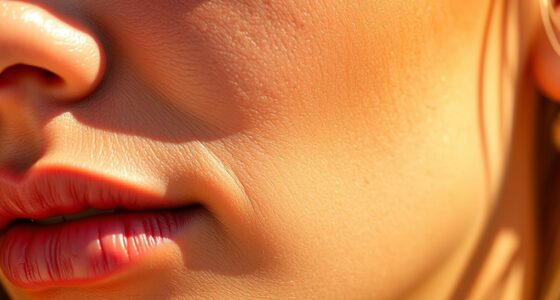Balancing vitamin D benefits from sunlight with UV damage risks requires careful exposure. Short periods of skin exposure to sunlight several times a week can help maintain adequate vitamin D levels without significant harm. Cover up or use protection during longer outdoor activities to reduce UV damage. Your skin type, location, and season influence how much sun you need. Staying informed can help you find the right balance for your health and skin safety.
Key Takeaways
- Short, regular sun exposure can boost vitamin D levels with minimal UV damage risk.
- Prolonged sun exposure increases UV damage, skin aging, and skin cancer risk, outweighing vitamin D benefits.
- Using sunscreen during extended outdoor activities blocks UVB, reducing vitamin D synthesis.
- Dietary sources and supplements provide safe vitamin D intake without UV-related skin harm.
- Balancing sun exposure timing and duration minimizes UV damage while maintaining adequate vitamin D levels.

While sunlight is essential for producing vitamin D, it also exposes your skin to harmful ultraviolet (UV) rays that can cause damage. This creates a tricky balance you need to manage carefully. Sun exposure triggers your skin to produce vitamin D, which is crucial for bone health, immune function, and overall well-being. However, too much UV radiation can harm your skin, leading to premature aging, sunburns, and increasing your risk of skin cancer. Understanding how to optimize vitamin D intake while protecting your skin health is key.
Balancing sun exposure for vitamin D benefits and skin protection is essential for health.
When you’re outdoors, your body responds to UVB rays by synthesizing vitamin D in your skin. This process is efficient, but it doesn’t require prolonged sun exposure. Just a few minutes of direct sunlight on your face, arms, or legs a few times a week can often meet your vitamin D needs. Yet, the more time you spend in the sun, the greater your risk of damaging your skin. UV rays penetrate deep into your skin layers, damaging the DNA in skin cells, which over time can lead to mutations and skin cancer. That’s why sun exposure, while beneficial for vitamin D, must be approached with caution.
You might think that wearing sunscreen negates the need for sun exposure, but it actually blocks the UVB rays necessary for vitamin D production. This means if you’re diligent about applying sunscreen during extended outdoor activities, your body might not generate enough vitamin D. Conversely, going without protection increases your risk of UV damage. Finding a balance involves exposing your skin to sunlight for short periods without sunscreen, then covering up or using protection later. This way, you can support your skin health by maintaining adequate vitamin D levels without markedly increasing your risk of damage.
It’s also worth noting that your skin’s response to sun exposure varies based on factors like skin type, geographic location, and time of year. Fair-skinned individuals tend to produce vitamin D quickly but are also more susceptible to UV damage. Darker skin offers more natural protection but might require slightly longer exposure to produce similar vitamin D levels. If you live in northern latitudes or spend most of your time indoors, you might need to consider dietary sources of vitamin D or supplements to avoid excessive sun exposure. Additionally, incorporating antioxidants into your diet can help mitigate some of the oxidative stress caused by UV rays.
Frequently Asked Questions
Can I Get Enough Vitamin D From Diet Alone Without Sun Exposure?
You can get enough vitamin D from diet alone if you include rich dietary sources like fatty fish, fortified dairy products, and egg yolks. However, it might be challenging to meet your needs solely through food, so consider supplement options if you’re at risk of deficiency. Always consult with a healthcare professional to determine the right approach, especially if sun exposure isn’t part of your routine.
How Does Skin Type Influence Vitamin D Synthesis and UV Damage Risk?
Your skin type greatly influences how your body synthesizes vitamin D and your UV damage risk. People with lighter skin pigmentation produce vitamin D faster because they have less melanin, which blocks UV rays. Conversely, darker skin offers more UV sensitivity protection, reducing damage risk but also slowing vitamin D production. So, your skin’s pigmentation affects the balance between getting enough vitamin D and avoiding UV damage.
Are There Safe Ways to Increase Vitamin D Without UV Exposure?
Yes, you can increase your vitamin D intake safely through dietary sources like fatty fish, fortified foods, and egg yolks, avoiding UV exposure. Supplements are also a reliable option, but you should check supplement safety by following recommended doses and consulting your healthcare provider. This way, you reduce UV damage risk while ensuring your body gets enough vitamin D for healthy bones and immune function.
Does UV Exposure Impact Skin Aging Independently of Vitamin D Production?
Think of your skin as a delicate canvas. UV exposure directly impacts it, causing photoaging effects like wrinkles and fine lines, independent of vitamin D production. UV induces inflammation, speeding up skin aging regardless of vitamin D synthesis. So, even if you’re not producing vitamin D, UV rays can still age your skin, making sun protection essential to preserve your youthful glow and prevent long-term damage.
How Do Seasonal Changes Affect Vitamin D Levels and UV Damage Risk?
Seasonal variation considerably impacts your vitamin D levels and UV damage risk. During summer, increased UV intensity boosts vitamin D production but also raises skin damage risk. In winter, lower UV exposure decreases vitamin D synthesis, potentially causing deficiencies, while UV damage risk diminishes. You should balance sun exposure carefully year-round, aiming for moderate exposure during peak UV months to maintain vitamin D levels without increasing skin damage.
Conclusion
Balancing vitamin D and UV exposure is like walking a tightrope—you want the sunlight’s benefits without falling into its dangers. While soaking up rays boosts your vitamin D levels, too much can cause damage that’s hard to repair. Think of it as a delicate dance; you need just enough to stay healthy without stepping into harm’s way. Stay mindful, and enjoy the sun’s warmth wisely—your skin will thank you for it.









